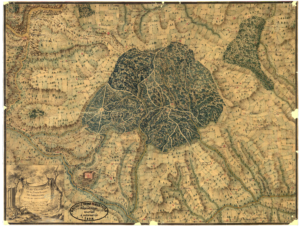THE GLASSES OF GRÉSIGNE

Penne and the master glassmakers of the Grésigne forest.
Penne, the sentinel of Grésigne
The Grésigne public forest, to the south-east of the Penne area, is home to one of the biggest oak groves in Europe. It takes its name from the large hollow of red sandstone where it developed (La Grésigne comes from « grès saigne » (« blood-red sandstone »).
From the year 1000 AD, the « honour » of Grésigne (with its woodland, pastures, quarries, streams and windmills, fortified houses and its inhabitants) mainly belonged to the lords of Penne. They remained the proud owners until the end of the 13th century, when they transferred it to the kings of France, who owned Penne from 1271. Until the 16th century, the French Crown entrusted supervision of Grésigne to the owners of the new royal fortress. It was administered by the Royal Dominion of the Waters and Forests of Languedoc. In 1669, King Louis XIV had a protective wall of over 12.6 km built around the forest to restrict access to it.
Until the French Revolution, the inhabitants de Penne, like those living in Puycelsi, Castelnau-de-Montmiral and even Gaillac, fiercely defended their rights to collect and use timber from the forest. Here they found the raw materials they needed for their daily life and work, as for example making winery containers, linked to the development of the Gaillac wine region.
The master glassmakers of the Grésigne forest
Master glassmakers first worked in the Grésigne forest in the 15th century and continued until the 19th century. Ten or so workshops were founded one after the other, making use of the forest’s abundant raw materials: silica from the sandstone as the main constituent of glass, wood for energy, water for washing and ash from eagle fern used as a fusing agent to lower the temperature of the silica. The master glassmakers controlled all the production process from the kilns to the shops where the finished products were sold.
The families of the master glassmakers had noble status. Many of them settled in the Penne area. One of the oldest was the « Grenier » or « Granier » family, with links to the region since the Renaissance. Their workshop and shop were in Haute Serre, at the edge of the Grésigne forest. The Grenier glassworks operated until 1852.
« Grésigne » glass has a highly characteristic green or blue-green colour. The pieces in our collection show the wide range of objects produced in the forest glassworks around Penne between the 17th and 19th centuries.

